#like concurrent discovery
Explore tagged Tumblr posts
Text

I see your transman Dib and raise you transman Zim as well 😌
#invader zim#iz zim#iz dib#zadr#zadf#trans dib#trans zim#not really zadr but tagged for my zadr homies#in honor of my first nebido shot lol#i hear its not common in usa though?#nebido is a shot in the butt that you only need every 3 months (continous release)#its done by a nurse not by yourself#im sure for zim its much more convenient. probably something he can pour into the pak#like. take off pak briefly. pour in T fluid. put pak on. pak dispenses T slowly over 3 months. repeat in 3 months#i think its funny if all of space uses the same stuff lmao#like concurrent discovery
81 notes
·
View notes
Text


It was never a common species, the blue-grey warbler that locals called the jack pine bird. A belated discovery among American birds, it was undescribed by science until the mid 19th century—and then, known only on the basis of a single specimen. The bird's wintering grounds in the Caribbean would eventually fulfill the demands of collectors and museums, but the intricacies of its lifecycle remained a mystery for decades, the first nest only found in 1903. As the already-rare bird became rarer, people could only guess at why. There were just so few birds to look for, their breeding habitat inscrutable amidst the dense, impassable woodland of their Midwestern home. The one clue was the most apparent thing about the bird: its affinity with the jack pine (Pinus banksiana).
Over time, more nests were found—not in the eponymous trees, as might be expected for a songbird, but on the ground at their feet. Data points converged, leading to the realization that not only did the bird nest almost exclusively in proximity to the scrubby pines, but only utilized trees that fell within a specific range: new growth, between five and fifteen feet tall, with branches that swept shelteringly close to the ground. Subsequently, it would be noticed that the greatest volume of specimen collection for the bird had corresponded with years in which historically significant wildfires had impacted the Midwest—fires that, for decades afterwards, had been staunchly suppressed. The pieces fell into place, like jack pine seeds, whose cones open only under the heat of a blaze.
With the bird's total population having dwindled to the low hundreds, a program of prescribed burns, clearcutting, and replanting was instituted, with many acres of land purchased and devoted to the preservation and maintenance of suitable breeding habitat. Concurrently, efforts were made to protect the vulnerable bird against brood parasitism by the brown-headed cowbird.
When the first federal list of protected species was put forward in 1966, the name of the small grey warbler was inscribed beside birds such as the Kauai ʻōʻō and the Dusky Seaside Sparrow.
The ʻōʻō, last of the genus Moho, would be removed from the list in 2023 due to extinction, after thirty-six years without a sighting.
The endling Dusky Seaside Sparrow, a male named Orange Band, would die of old age in captivity in 1987, with his species being delisted three years later.
in 2019, fifty-two years after the creation of the Endangered Species Protection Act, the name of Kirtland's warbler, too, was removed from the list: it had been determined that, with a population now numbering nearly 5000, the jack pine bird could be considered safely stable.
Conservationists continue to work to preserve the breeding habitat of Kirtland's Warbler in the midwestern US, as well as its winter roosts in the Bahamas and neighboring islands (though selective logging has replaced actual burning in recent years, due to the dangers posed by unpredictable fires). It's the kind of effort that it takes to undo the damage we've caused to the planet and its creatures—the kind of hope that we need, to not give up on them, or on ourselves.
-
The title of this piece is Prescribed Burn (Kirtland's Warbler). It is traditional gouache on 18x24" watercolor paper, and is part of my series Conservation Pieces, which focuses on efforts made to save critically endangered birds from extinction.
#kirtland's warbler#conservation#bird art#extinction stories#bird extinction#endangered species#series: conservation pieces
1K notes
·
View notes
Text
Klingon D7/K'tinga Battlecruiser continuity DEEP DIVE!

Where it all began in TOS, designed by W. Matt Jeffries. The name D7 was an on-set in-joke between Shatner and Nimoy which stuck.

When Star Trek rebooted it's Klingons for The Motion Picture, they added tons of surface detail to the Klingon Battlecruiser too. The name "K'tinga" was given in the TMP blueprint pack (although the model was called "Koro class") and it stuck. This was considered the Klingons' equivalent to the refitted Enterprise seen in the movie.

Deep Space Nine's "Trials and Tribble-ations" crossed DS9 over with TOS' "The Trouble With Tribbles", and the DS9 VFX crew built all-new physical models for visual effects - and Greg Jein chose to add a green tint and K'tinga-style surface detail to the TOS D7 battlecruiser, making us all wonder if they were really meant to be the same ship type all along.

Voyager's "Prophecy" would show us a Klingon "D7" battlecruiser in the Delta Quadrant. Although called a D7 in the script, the CG model is clearly based upon the TMP K'tinga, with the extra hull detailing.

Doug Drexler designed this ⬆️D4 Battlecruiser for Star Trek: Enterprise's "Unexpected" as a predecessor for the ship seen in TOS. But The Powers That Be decided the ship didn't have enough windows (yes, really) and requested the D7/K'tinga CG model from Voyager be used instead⬇️ putting it's first appearance 150 years earlier in 2151.


For the TOS Remastered HD TOS project, the original look for the Klingon D7 Battlecruiser was retained, albeit in a somewhat low-poly PS2-ish form
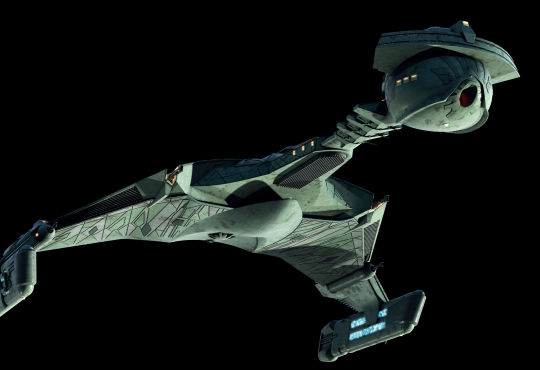
The Klingon Warbird, seen during the Kobayashi Maru sequence of the 2009 reboot movie (and more so in the deleted scenes, surrounding the damaged Narada before Nero's imprisonment at Rura Penthe), was literally the TMP K'tinga with extra stuff bolted on and smaller windows implying an upscaling to match the enormous Starfleet ships in the Kelvin universe.
The Pike-era novel Children of Kings would reconcile the huge Klingon Warbird by saying it was a larger version of the Battlecruiser (of course, Klingons are no strangers to upscaling their Bird of Prey) and most feared ship in the Klingon fleet
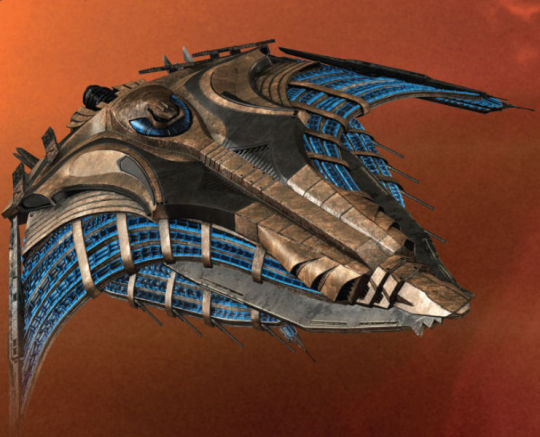
Fast forward to 2017. Star Trek: Discovery has rebooted the look of the Klingons again and this time their ships as well, ten years prior to TOS. And in "Choose Your Pain" this ship ⬆️ (called Sech-class in behind-the-scenes art) is called a D7. But then fast-forward to season 2, when 5 concurrent series' of Trekspam were planned out, tying more closely into previous canon and Discovery backpedaled somewhat on it's unique designs - and a "new" D7 battlecruiser (a more modest updating of the Klingon D7/K'Tinga design, upscaled like the Kelvinverse version to match the bigger Discovery/Strange New Worlds ships) was planned as a unified design to united the 24 Klingon great houses, ignoring ENT: "Unexpected" and Disco's own "Choose Your Pain":

So yeah, the D7 class may or may not be the same as the K'tinga class, and it appeared "first" in 2151 and again in 2257.
#star trek#deep dive#klingons#starship design#star trek tos#ds9#voyager#star trek aos#kelvin timeline#star trek discovery#strange new worlds
161 notes
·
View notes
Photo

The Tempest
The Tempest is a play by William Shakespeare (c. 1564-1616), written in 1610 or 1611, and first performed for the court of James I of England (r. 1603-1625) on 2 November 1611. Believed to be the last play that Shakespeare wrote on his own, The Tempest deals with both tragic and comic themes, leading some literary critics to label it under the category of 'romance' or 'tragicomedy'.
Sources & Themes
Unlike many of Shakespeare's other works, there does not seem to be a direct literary source for The Tempest. Instead, it seems that Shakespeare was inspired by accounts of New World exploration, which was gaining traction during that time. Shakespeare had likely heard accounts of Ferdinand Magellan's circumnavigation of the world and had read Richard Rich's News from Virginia (1610). One of his main sources was William Strachey's A True Reportory of the Wreck and Redemption...from the Islands of the Bermudas, an eyewitness account of the wreck of the Sea Venture, a ship that went down off the coast of Bermuda in 1609. Since Strachey's full manuscript was not published until after Shakespeare's death, it is thought that the playwright had access to an early draft. Certainly, the excitement surrounding the discoveries in the Western Hemisphere provided the fabric of The Tempest's plot, even though it is narratively set on an island in the Mediterranean.
The island on which the play is set, in the words of David Bevington, is a place of "magical rejuvenation", a realm of art where "everything is controlled by the artist-figure" (818). In this way, the island itself is like a stage, and Prospero with his magic is like Shakespeare with his pen. There are several references within the play to theatre and actors, leaving some scholars to speculate that The Tempest may have been Shakespeare's way of saying farewell to his career, since it was the last play he wrote alone.
Another theme is that of colonialism, most clearly demonstrated with Prospero coming to the island, enslaving the native Caliban, and forcing Ariel to do his will. There are obvious parallels to the concurrent European colonization of the Americas, but Shakespeare's audience would have been more likely to think of the English exploitation of Ireland, which had taken an especially brutal turn. Caliban's enslavement, though presented by Prospero as necessary to prevent rape and disorder, nevertheless raises questions of oppression and control and leaves the audience to wonder whether Prospero's attempts to 'civilize' Caliban and contain his otherness has produced a worthy result.
Read More
⇒ The Tempest
#History#TheTempest#Caliban#JacobeanTheatre#Prospero#Shakespeare'sPlays#Tragicomedy#WilliamShakespeare#WHE
54 notes
·
View notes
Text
The Harbinger
[One] [Two] [Three] [Four] [Five]
Rating: M
Pairings: Semi Eita/Shirabu Kenjirou, Goshiki Tsutomu/Shirabu Kenjirou, Semi Eita/Tendou Satori
Other Relationships: Ushijima Wakatoshi/Tendou Satori, Shirabu Kenjirou & Tendou Satori, Shirabu Kenjirou & Ushijima Wakatoshi
Themes/Tropes: Magic AU, Demon Hunter AU, Demon AU, Self-Discovery, Identity Issues, Emotional Hurt/Comfort, Quest Narrative, Team as Family, Polyamory

Shirabu shifts away. “I said I want to be alone,” he snaps, immediately regretting it when he sees Semi freeze.
Semi’s hand closes into a fist as it lowers to his side. “Fine,” he says quietly. “But your thoughts are only going to get louder if you’re by yourself. Trust me, I know.”
“I can handle my thoughts,” Shirabu mutters.
“We want to help you.” Semi lifts his hand helplessly to the side.
“You can’t even talk about it!” Shirabu exclaims, louder than he means to. “You all just act like it never even happened! Like I didn’t almost kill you all!” He throws his hands up in agitation. “Everyone’s playing pretend, and it’s fucked up! We’re not this normal happy little family, and I’m sick of everyone acting like it is!”
Semi looks shocked, his eyes widening. “We just want you to feel safe and loved,” he says. “To know we’re not afraid of you.”
“MAYBE YOU SHOULD BE!”
Plagued by nightmares and the knowledge of his demon heritage, Shirabu Kenjirou goes on a quest to track down and kill his biological father. Accompanied by his friends, he must traverse various demon realms and the horrors within, all while resisting the pull of his demonic energy that continues to grow stronger and threatens to destroy everything he holds dear. Set a few months after “The Awakening” and before/concurrently with “Hikari Are,” as Malikra increases his power within the Hell Dimension, will the Demon Hunters of Shiratorizawa rise or fall?
( @semdere , @shiratorizawa-academy , @kats-main-blog , @pulveremcomedesligulas )
8 notes
·
View notes
Text
Tiān Guān Cì Fú Hanakotoba Analysis Part 1

◤━━━━━━━━━◥✿◤━━━━━━━━━◥
-> 1) Peach Blossom/Plum Blossom/Cherry Blossom

While the flowering trees featured in the donghua as well as in its opening credits, official artwork and ending credits could be plum blossoms (Prunus mume) or cherry blossoms (Prunus serrulata), they are most likely to be peach blossoms (Prunus persica). Despite the fact that they can be difficult to differentiate between at times, especially when referencing a drawing, these three blossoms do have a few distinguishing features, which are as follows. Peach blossoms have pointed petals, plum blossoms have rounded petals, and cherry blossoms have a notch at the tip of their petals. Peach blossoms produce two flowers from a single node, whilst plum blossoms produce one flower per node and cherry blossoms produce several flowers per node. Finally, while plum and cherry blossoms develop leaves after their blossoms fall, while peach blossoms seem to produce leaves concurrently with flowering. Despite these distinctions, these flowers are frequently confused with one another, resulting in a significant overlap in their symbolic meanings throughout different cultures; thus, my decision to feature them all here.
1.1) Peach Blossom

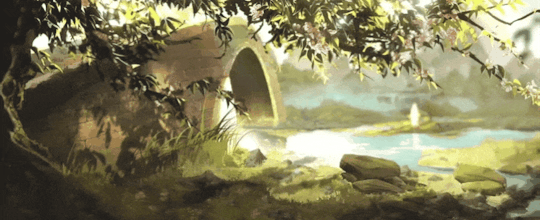
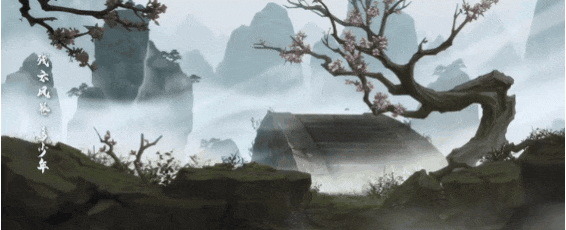
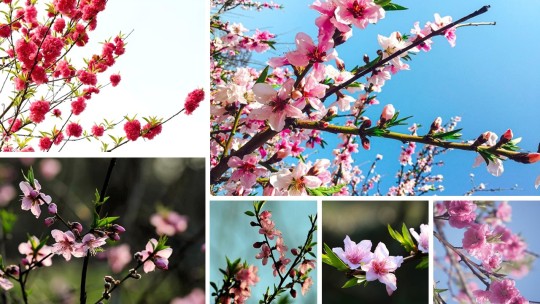
Peach blossoms are known as táohuā (桃花) in Chinese. They symbolise immortality, vitality, longevity, peace, good luck, success and prosperity in Chinese culture. Furthermore, peach tree wood was believed to protect humans from evil spirits, therefore branches were hung above doorways to drive demons away, and peach wood wands were used in exorcisms. Furthermore, its Chinese name “táohuā” has the figurative meaning of “luck in love affairs; luck in love”. Peaches are also known as senki or senka in China (meaning tree or fruit that gives power to the gods), and it has been believed since ancient times that peaches have the divine power to grant people perpetual ageing and longevity. Peach blossoms are known as momo (桃) in Japanese. Its meanings in hanakotoba are “I am your captivator”, “invincible under heaven” and good-natured. Its symbolic meaning of "invincible under heaven" stems from the fact that peach has traditionally been used to fend off evil spirits and as a spiritual medicine for immortality. In Western floriography, peach blossoms symbolize longevity, gentleness, honour, peace, happiness and generosity. The peach blossom also has the meanings "I am your captive" and "your charms are unrivalled qualities." The peach blossom has been used as a symbol of renewal and growth in Western literature.Xie Lian’s infamous quote “Body in the abyss, heart in paradise” (MXTX, p. 6) is translated from the original “Shēn zài wú jiàn, xīn zài táo yuan” (身在无间, 心在桃源)—which can be roughly translated as “Body in Wujian, heart in Taoyuan”. The word "paradise" in his quote actually corresponds with the Chinese phrase "táo yuan" (桃源)—which is short for táohuāyuán (桃花源)—which means "peach blossom valley," and is a saying for paradise/heaven. The phrase is taken from the title of Tao Yuanming's 421 CE fable, which details a chance discovery of an ethereal paradise where its inhabitants live an ideal existence in harmony with nature for centuries, remaining oblivious of the outside world. This phrase can also refer to an idealistic place of serenity and rest, but it is also used to refer to an unrealistic fantasy. Additionally, the peach blossom’s symbolic meanings of immortality, longevity, good luck, generosity, honour, good-natured, prosperity and “invincibility under heaven” as well as its association with gods and divine power suit the attributes of the heavenly realm—which is where they are primarily seen in the series—as well as the values its officials are meant to aspire to. The tree’s symbolic meanings of “your charms are unrivalled qualities”, “luck in love”, renewal and growth greatly complement Xie Lian and Hua Cheng’s relationship. Despite having his luck sealed away and being catastrophically unlucky from then on, Xie Lian was extremely fortunate in discovering profound and enduring love. Furthermore, Xie Lian's immense generosity and compassion for people, albeit an unattainable ideal for many, was part of what drew Hua Cheng to him: "If your dream is to save the common people, then my dream, is only you" (MXTX, p. 1953). This corresponds to the peach blossom's association with dignity, serenity, charity, and "unrivalled charms". The scene in the second season's ending theme visuals during which a peach tree branch is shown enduring weather conditions throughout all four seasons is a representation of Hua Cheng's patience and dedication while searching for Xie Lian during the 800 years between the latter's second banishment and third ascension. It also parallels Xie Lian's patience and fidelity while waiting for Hua Cheng's return after the final battle.
1.2) Plum Blossom


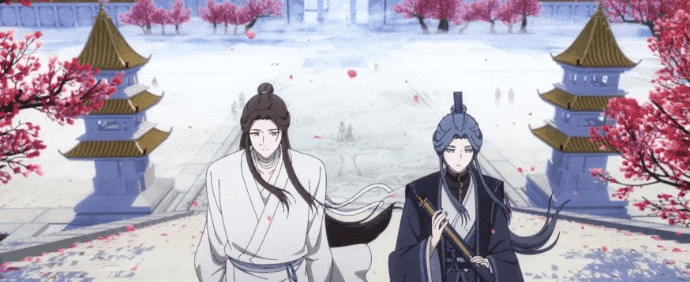
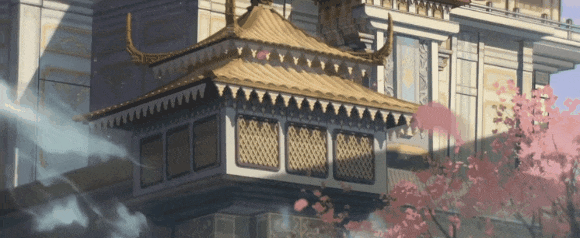
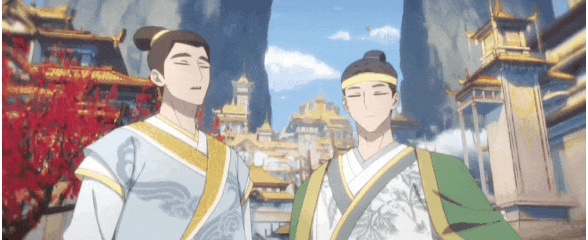
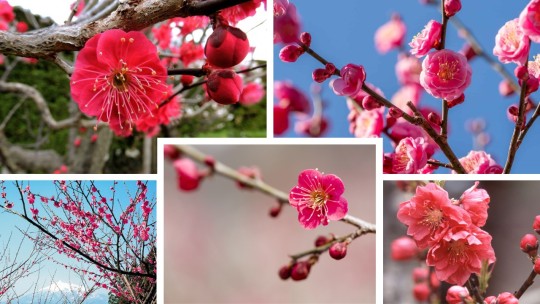
Plum blossoms are known as méihuā (梅花) in Chinese. They hold the symbolic meanings of endurance, perseverance, vitality, inner strength, hope and thriving through adversity in Chinese culture because they are one of the hardiest flower species in the world and blossom during winter defying all the vagaries of winter weather. When their blossoms valiantly emerge during the latter weeks of winter, they are seen as a hopeful omen of spring and are treasured for their splendour during the darkest time of year. Plum blossoms thus herald the arrival of spring and signal the end of winter. Plum blossoms are also China's national flower, serving as a national symbol. Plum blossoms are associated with longevity because their blossoms remain in flower for a month. Plum blossoms can also represent those with a strong personality who are unafraid of difficulties. In Japan, plum blossoms are known as ume (梅). Its meanings in hanakotoba include integrity, patience, elegance, loyalty and faithfulness. In Western floriography, plum blossoms symbolise keeping promises, fidelity, beauty and longevity. Plum blossoms are also associated with the end of winter and represent hope, tenacity, perseverance, courage, and beauty's capacity to overcome adversity. Furthermore, plum blossoms represent prosperity, fruitfulness, beauty, purity, and good fortune. Wild plum blossoms in particular represent independence. The intricate dynamics of Hua Cheng and Xie Lian's relationship are complemented by the symbolic meanings of hope and the onset of spring evoked by plum blossoms. After 800 years of roaming alone, Xie Lian meets Hua Cheng. Bringing a sense of fulfilment, excitement, and happiness to his life that he hadn’t felt in a long time; as he told Hua Cheng, "Only after meeting you, did I rediscover that it's such a simple thing to be happy" (MXTX, p. 1060). Plum blossoms can also represent individuals who possess strong personalities and are not intimidated by challenges, which complements Xie Lian's character well. Despite being subjected to tremendous adversity, he continues to be as unyielding and resilient as he was before his first banishment, remarking, "I might not be able to decide whether the road is easy or not, but whether I walk it is entirely up to me" (MXTX, p. 1125). The plum blossom’s symbolic meanings of integrity, patience, fidelity, perseverance, courage, beauty, independence and elegance also complement Xie Lian’s character. The plum blossom’s symbolic meaning of keeping promises greatly aligns with Hua Cheng’s character, especially when referencing his declaration to Xie Lian near the end of the novel, "There is no banquet in this world that does not come to an end...but I will never leave you. I will come back...Your Highness, believe me" (MXTX, p. 1954). True to his promise, he defies death once more to return to Xie Lian after replenishing his spiritual power for an indeterminable amount of time. Hua Cheng’s unwavering devotion to Xie Lian is a core part of his character which also ties into the plum blossom’s meanings of fidelity, loyalty and faithfulness. Hua Cheng’s favourite poem referenced in the novel—Ache of Separation by the Tang poet Yuan Zhen—is a reference to his immense devotion. The poem states “After seeing the vast sea, no water can compare; Scattered from the peak of Mount Wu, there are no other clouds… Many times I’ve passed through the flowers, yet I spare them no glance; For half my fate is in cultivation, and the other half, in you.” This poem, which is akin to Hua Cheng's feelings for Xie Lian, describes the poet's unwavering love and devotion for his late wife Wei Cong and how nothing and no one else can compare to her presence in his life. This once more relates to the plum blossom representing devotion, loyalty, and fidelity.
1.3) Cherry Blossom
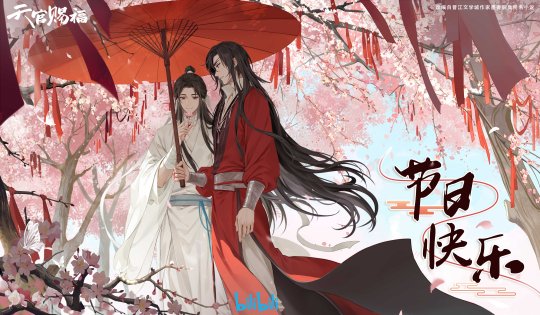
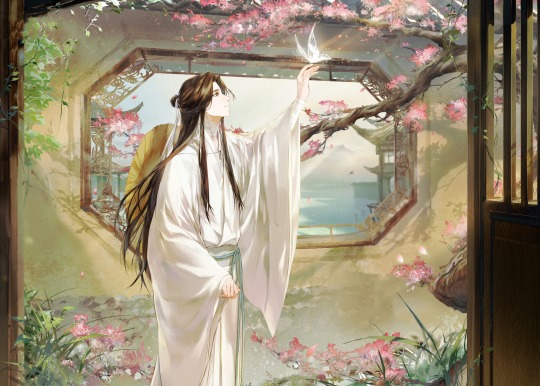
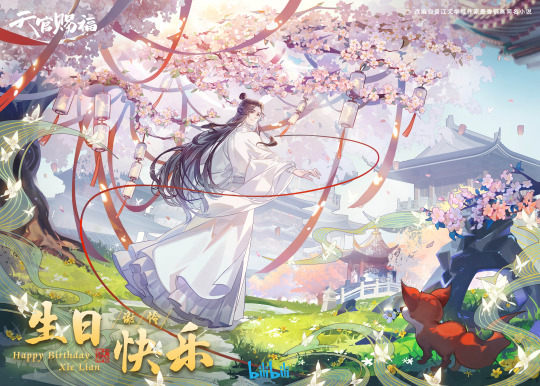
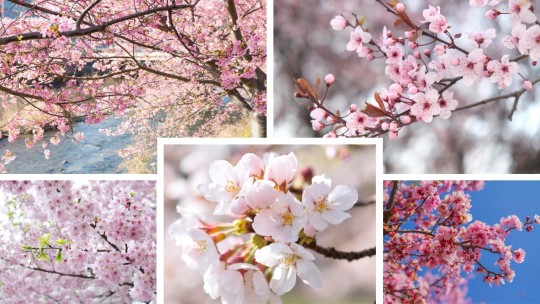
The cherry blossom (Prunus serrulata) is also known as the Japanese cherry and is the unofficial national flower of Japan. Its Japanese name Sakura (桜) has been derived from the word “saku” which means “to bloom”. Its meanings in hanakotoba are “beauty of spirit”, grace, chastity, excellent beauty, gentleness, good education and the “transience of life”. In Japan, cherry blossoms are also a symbol of the “beauty of impermanence”—a Shinto concept better known as “mono no aware” (物の哀れ) as their falling petals are a reminder that although life is short, it is beautiful and should be savoured. The Japanese concept of “natsukashii” (懐かしい) likewise emphasizes the fleeting nature of cherry blossoms. This concept refers to the happy-yet-wistful nostalgia for times and things that we will never be able to go back to. We will never get to experience those moments again, just like the ephemeral cherry blossoms, which makes them even more significant. Cherry blossoms bloom from March to April which is the start of the new fiscal year in Japan. As a result of this cherry blossoms have also come to symbolise new beginnings and springtime. Given that feudal Japanese soldiers associated cherry blossoms with honour, discipline, and dignity—falling flowers were thought to be symbolic of a Samurai's death. In Western floriography, cherry blossoms herald the changing of the seasons and symbolise renewal and rebirth. They also symbolise the fleeting nature of life, tenderness, forgiveness, strength, beauty, love, confidence, peace, friendship and gratitude.
In China, most of the Cherry blossom’s Japanese symbolic meanings are more strongly associated with plum blossoms. Cherry blossoms are known as yīnghuā (樱花) in Chinese and symbolise life, beauty, femininity, power and mysteriousness in Chinese culture. While still occasionally connected to the concepts of life and death, Cherry blossoms are more connected to the concepts of love and romance as well as beauty and femininity in Chinese culture.
Cherry blossoms are primarily associated with the transiency of life. In Xianxia novels like Tiān Guān Cì Fú, where characters can achieve immortality through cultivation, themes such as the transiency of life are not majorly relevant. However, in Tiān Guān Cì Fú, gods are powered by the faith and worship of their followers and without this faith they would fade into non-existence. These Heavenly Officials are not all-powerful but are beholden to fate like all other living things and are capable of death. It was also stated by MXTX, that Heavenly Officials banished or not, are not included in the wheel of reincarnation after death. This reaffirms that while long-lived, “when humans ascend, they are still human; when they fall, they are still human” (MXTX, p. 541). Xie Lian’s first 2 ascensions and subsequent banishments are also reminiscent of the fleeting nature of life—“He ascended to the heavens quickly, but his fall from grace was even faster” (MXTX, p. 10). At one moment he was ��the crown prince who pleased the gods”, at the pinnacle of prominence and the next he was “the laughingstock of the three realms”. This ties in with the cherry blossom’s representation of the fleeting nature of life. Xie Lian’s words to Hua Cheng in chapter 31—“Those who have known each other for decades can become strangers in a day. We've met by chance, and we may part by chance. If we like each other then we shall continue to meet; if we don't, then we shall part. At the end of the day, there's no banquet in the world that doesn't come to an end, so let's go all more with the flow, and I'll say what I want to say” (MXTX, p. 267)—are also reminiscent of the fleeting nature of life.
The Cherry Blossom’s association with the “happy-yet-wistful nostalgia for times and things that we will never be able to go back to” is reminiscent of Xie Lian’s halcyon days before his first ascension as well as the friendship of the Xianle Trio before the fall of Xianle. Additionally, the cherry blossom also symbolizes strength, dignity, “beauty of spirit”, peace, forgiveness gratitude, friendship and tenderness which are all qualities that can be associated with Xie Lian.
-> 2) Peony
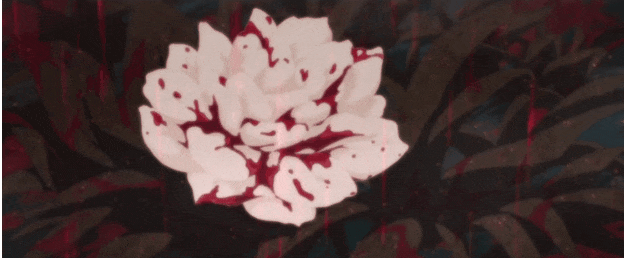


“At the corner of the jade altar table sat a tiny, lonesome flower. A far-gone memory surfaced in Xie Lian’s mind, and he was momentarily stunned. It was like a dust-covered picture, but when he tried to wipe it clean, it remained blurry. Unspeaking, he frowned and loosened his grasp to pick up that flower. Hua Cheng put down his brush as well and slowly began to grind some ink. “What’s wrong?” Xie Lian smiled. “Nothing. Just…this flower’s scent is refreshing. I’ve always liked this sort.” Offerings of flowers in temples and palaces were far from rare. However, most devotees offered large, fresh bouquets of bright red or purple blossoms, or handcrafted imitation flowers that never wilted. After a pause, Xie Lian said, “Could this be the flower which Crimson Rain sought?” Hua Cheng smiled. “Gege has such godly premonitions.” (MXTX, pp. 765-766) Despite the flower Hua Cheng shielded from the blood rain after raiding Qi Rong's hideout—“…a shower of blood rain poured down from the skies. He saw a flower was getting battered by the bloody rain, so he tilted his umbrella and shielded it” (MXTX, p. 120)—earning him the alias "crimson rain sought flower”, it is never named in the novel. It is however confirmed to be the same kind of flower he always places as an offering on the altar of Xie Lian's temple. In the donghua however, it is portrayed as a white peony (Paeonia). Peonies are known as mǔdān (牡丹) in China and were regarded as China’s national flower during the Tang Dynasty (618 to 907 A.D.). In accordance with this, they symbolise prosperity, honour, wealth and beauty, love and happiness. The Chinese term for peonies means "the most beautiful” while other Chinese names for peonies are "fùguìhuā" and "huawang," which translate to "king of the flowers" and "flower of riches and honour," respectively. In Japan, peonies are called botan (牡丹) and symbolize shyness, wealth and regalness in hanakotoba. The flower's profound appearance, notably its multitudes of large petals that are thin and silk-like, is considered to be where the peony symbolising wealth and regalness originated. In Western floriography, peonies represent bashfulness and compassion. It is speculated that the reason Hua Cheng shielded the white flower to prevent it from being stained by the blood rain is because he associated the flower with Xie Lian.
-> 3) Wild Rose
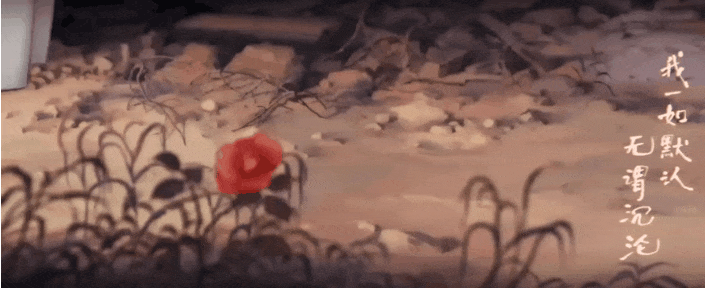


The flower featured in the above panel is likely a red rose. In China, roses are known as méigui (玫瑰), and in accordance with their universal symbolism, they are strongly associated with romance, passion and love. Thanks to the Chinese monthly rose (Rosa chinensis), which blooms in almost every month of the year, creating a "spring" that never ends, roses are also associated with longevity and the perpetual spring in China. Considering that the colour red is auspicious, red roses are also thought to bring good fortune in China. In Japan, roses are called bara (薔薇) and its meaning in hanakotoba is love and beauty. Red roses in particular symbolize affection and passionate love; while rose thorns represent “happiness in misfortune”. In Western floriography, roses symbolize love, passion, beauty, romance and secrecy. Red roses symbolize enduring passion, desire, affection and romance. A single rose is said to symbolize love at first sight. The rose flower’s symbolic meanings of enduring passion, romance, “love at first sight” and secrecy tie in well with Hua Cheng and his motivations—“My beloved is a brave, noble, and gracious special someone. He’s saved my life; I’ve looked up to him ever since I was young. But, I wanted to catch up to him more, and become an even stronger person for him. Although he might not remember me well. We never really talked. I want to protect him” (MXTX, p. 1953). The wild rose flower depicted in the opening is seen wilting as Xie Lian walks by leaving only thorns. This could be a depiction of how Xie Lian’s naïve, fragile passion from his youth has long since wilted leaving behind someone wiser who is able to find happiness in misfortune and life’s simplicities. The scene could also possibly be an allusion to how in the novel’s original character concepts Xie Lian was supposed to become a flower god in charge of flowers blooming and wilting after being banished.
◣━━━━━━━━━◢✿◣━━━━━━━━━◢
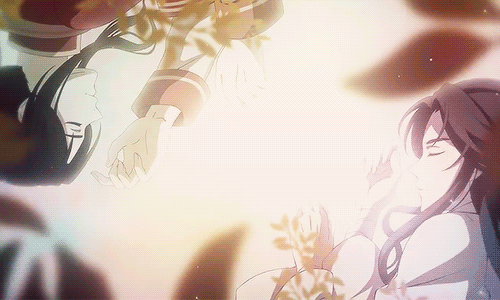
╰┈➤ Part 2 𐀔
╰┈➤ Anime Hanakotoba Posts Directory
[I had to split this post in half due to Tumblr's image/gif limit so please find part 2 on my blog. Also, I wanted to post this on the release date for S2 of the donghua but felt like the post wasn't ready yet so decided to postpone it till this week. If you liked this post, check out my other hanakotoba analysis posts... Also, if I've gotten any of the kanji, romaji, hanzi or pinyin incorrect, feel free to correct me]
#tgcf#tian guan ci fu#mxtx#mxtx tgcf#mo xiang tong xiu#donghua#danmei#anime#anime hanakotoba#hanakotoba#floriography#hanakotoba analysis#tgcf donghua#tgcf season 2#tgcf s1#tgcf s2#heaven official's blessing#hualian#hua cheng#xie lian#san lang#sanlian#hua cheng x xie lian#hua cheng/xie lian#huaxie
72 notes
·
View notes
Text
Thinking about Bug Buddies again because I cannot get over Lala Barina. Since it looks like the Research Expedition is running several different operations concurrently from the Wilds camp please imagine another unit created to study any historical Rider connections amongst villages and cultures in the Forbidden Lands, given the discovery of the Seikret (palamutes I can understand the Guild not asking questions about, but here's a new domesticated wyvern).
The unit:
Rider and Hunter pair -> heavy hitters
Smithy (2) -> doubled to deal with increased gear demands
Scrivener -> liaison between the Royal Paleontology Scriveners and the Hunters Guild.
Their Rider can't operate a Slinger to save their life, but that's alright because their Nerscylla more than makes up for it. They eventually hunt down a Lala Barina and in true Rider fashion, steal an egg. Now they have a fluffy baby spider. The other units don't quite know how to deal with them but at the same time they're also looking forward to the day when the fluffy bug is big enough that they can all nap in luxurious fluff on their off time. That must be an experience.
The Nerscylla's official name is Battle Bug but we call her BB for short. They also call the tiny Lala Barina "Baby" so if you call one, the other is also scuttling along behind. It's cute if you call for BB and get the baby as an extra. It's terrifying if you call for the baby and get BB looming out of the darkness at you.
#thinking about them again#I love the armor what the hell#lala barina#monster hunter wilds#hunter and rider dynamics#nerscylla#here's a fic idea I don't know when I'm going to touch again
16 notes
·
View notes
Text
Within the Sanctuary of Wings review

5/5 stars Recommended if you like: adventure, light academia, dragons, epistolary narrative
A Natural History of Dragons review
The Tropic of Serpents review
Voyage of the Basilisk review
In the Labyrinth of Drakes review
So...I still enjoyed this book, but I'm not totally sure how I feel about the big discovery made in this one. I do think it's a little odd and abrupt, but I can also see how the groundwork was laid in prior books.
This book opens 6 years (I think) after Labyrinth with Suhail giving a talk on Draconean linguistics and translation. The 'Cataract Stone' Isabella found in Mouleen provided a bilingual transcription that Suhail and other linguists were able to use to begin cracking the code of the Draconean language. Since the discovery of the stone and the bigger discovery of the mostly intact ruins in the Labyrinth of Drakes, there has been a huge boom of all things Draconean in Scirling society. For those familiar with the Victorian era, this tracks very closely with the Egyptian boom that occurred and, obviously, the Cataract Stone here is analogous to the Rosetta Stone in our world--Draconean art has always been described in a way analogous to Egyptian art, so I thought this was very nice continuity.
Toward the end of the first chapter, a Yelangese rebel and mountain climber, Mr. Thu, approaches Isabella to tell her about a dead dragon he found in the Mrtyahaima mountain range (i.e., Himalayas). Due to her past with Yelang, she's obviously wary, but it involves dragons, so obviously she, Tom, Suhail, and Andrew take off for Mrtyahaima. Caeligers are much more prominent now and there's even an event called the Aerial War that's occurring concurrently in the world. Thus, traveling to a remote and treacherous mountain range is a bit easier than when Isabella and Tom did it in book 1. Of course, getting to the mountain range is one thing, getting around once there is another.
Suhail's archaeological and linguistic work plays an important role in this book, but Isabella's theory of reproductive lability comes back in a big way as well. I liked seeing the convergence of some of these ideas, and I did appreciate that language was a bigger aspect in this one than in some of the other books (while I did study anthropology and find it fascinating, linguistics is my passion).
It's hard to talk too much about this book without giving away some very big spoilers that have been building for the entire series. I will say though that Isabella spends much of this book separated from her loved ones, and that a lot of her scientific work is done via observation. While this is true of most of the series, we were treated to some of her hands-on work in Labyrinth, so really this is just her going back to her usual style of fieldwork. The discovery and actions she takes in this book are the reason she goes from Dame Trent to Lady Trent, and is essentially a household name in Scirling forevermore.
I will say, for all her grumbling about not being good at politics, Isabella is actually very smooth when it comes to political maneuvering in this book. First she has to convince the Scirling government to let her go to Vidwatha (India) and Tser-nga (I am guessing Nepal) on the word of a Mr. Thu who, in exchange, wants her to pledge support to the revolutionary movement in Yelang. Then she runs into political problems later on with another group she runs across, and then she finds a surprising, but completely Isabella, way of following through on her promise of supporting the Yelangese revolution.
When the whole group is together, I enjoy their interactions and the way they're all familiar enough with one another to essentially read each other's minds. As usual, Suhail and Tom both have academic interest in the same/similar things as Isabella, and so the three of them are excited at the prospect of new discoveries. I like that Andrew has essentially become a member of their little group despite not being an academic. He's able to provide support in interesting ways.
Overall, a good and surprising ending to the series that combines the work Isabella and Tom have been doing for 5 books with Suhail's work. I'm definitely excited to read the spinoff/sequel/companion and see how the discoveries here have impacted things down the line.
#book#book review#books#book recommendations#bookblr#bookaholic#booklr#bookstagram#bookish#fantasy#marie brennan#dragons#fantasy books#fantasy novel#epistolary narrative#light academia#lady trent#lady trent memoirs#a natural history of dragons#the tropic of serpents#voyage of the basilisk#in the labyrinth of drakes#within the sanctuary of wings
8 notes
·
View notes
Text

Webb finds early galaxies weren’t too big for their britches after all
It got called the crisis in cosmology. But now astronomers can explain some surprising recent discoveries.
When astronomers got their first glimpses of galaxies in the early universe from NASA’s James Webb Space Telescope, they were expecting to find galactic pipsqueaks, but instead they found what appeared to be a bevy of Olympic bodybuilders. Some galaxies appeared to have grown so massive, so quickly, that simulations couldn’t account for them. Some researchers suggested this meant that something might be wrong with the theory that explains what the universe is made of and how it has evolved since the big bang, known as the standard model of cosmology.
According to a new study in the Astronomical Journal led by University of Texas at Austin graduate student Katherine Chworowsky, some of those early galaxies are in fact much less massive than they first appeared. Black holes in some of these galaxies make them appear much brighter and bigger than they really are.
“We are still seeing more galaxies than predicted, although none of them are so massive that they ‘break’ the universe,” Chworowsky said.
The evidence was provided by Webb’s Cosmic Evolution Early Release Science (CEERS) Survey, led by Steven Finkelstein, a professor of astronomy at UT Austin and study co-author.
Black Holes Add to Brightness
According to this latest study, the galaxies that appeared overly massive likely host black holes rapidly consuming gas. Friction in the fast-moving gas emits heat and light, making these galaxies much brighter than they would be if that light emanated just from stars. This extra light can make it appear that the galaxies contain many more stars, and hence are more massive, than we would otherwise estimate. When scientists remove these galaxies, dubbed “little red dots” (based on their red color and small size), from the analysis, the remaining early galaxies are not too massive to fit within predictions of the standard model.
“So, the bottom line is there is no crisis in terms of the standard model of cosmology,” Finkelstein said. “Any time you have a theory that has stood the test of time for so long, you have to have overwhelming evidence to really throw it out. And that’s simply not the case.”
Efficient Star Factories
Although they’ve settled the main dilemma, a less thorny problem remains: There are still roughly twice as many massive galaxies in Webb’s data of the early universe than expected from the standard model. One possible reason might be that stars formed more quickly in the early universe than they do today.
“Maybe in the early universe, galaxies were better at turning gas into stars,” Chworowsky said.
Star formation happens when hot gas cools enough to succumb to gravity and condense into one or more stars. But as the gas contracts, it heats up, generating outward pressure. In our region of the universe, the balance of these opposing forces tends to make the star formation process very slow. But perhaps, according to some theories, because the early universe was denser than today, it was harder to blow gas out during star formation, allowing the process to go faster.
More Evidence of Black Holes
Concurrently, astronomers have been analyzing the spectra of "little red dots" discovered with Webb, with researchers in both the CEERS team and others finding evidence of fast-moving hydrogen gas, a signature of black hole accretion disks. This supports the idea that at least some of the light coming from these compact, red objects comes from gas swirling around black holes, rather than stars – reinforcing Chworowsky and their team’s conclusion that they are probably not as massive as astronomers initially thought. However, further observations of these intriguing objects are incoming, and should help solve the puzzle about how much light comes from stars versus gas around black holes.
Often in science, when you answer one question, that leads to new questions. While Chworowsky and their colleagues have shown that the standard model of cosmology likely isn’t broken, their work points to the need for new ideas in star formation.
“And so there is still that sense of intrigue,” Chworowsky said. “Not everything is fully understood. That’s what makes doing this kind of science fun, because it’d be a terribly boring field if one paper figured everything out, or there were no more questions to answer.”The James Webb Space Telescope is the world’s premier space science observatory. Webb is solving mysteries in our solar system, looking beyond to distant worlds around other stars, and probing the mysterious structures and origins of our universe and our place in it. Webb is an international program led by NASA with its partners, ESA (European Space Agency) and CSA (Canadian Space Agency).
7 notes
·
View notes
Note
Thoughts on cygate (cyclonus x tailgate) ?
Cygate is one i love but i have complicated feelings toward.
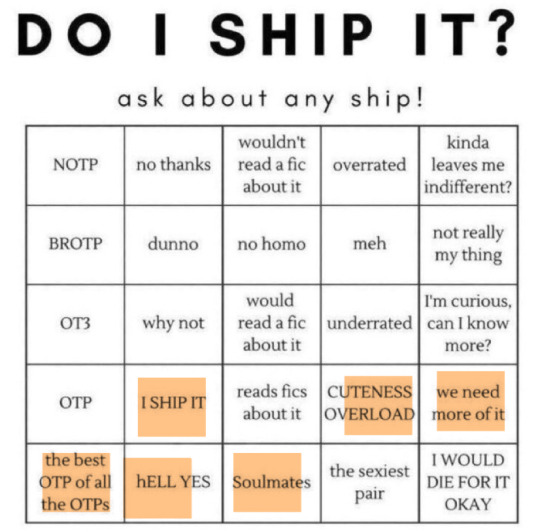
tw somewhat unpopular opinion and these are myyy opinions so if it's not yours that's fine !!r
I really like it but i think the way the fandom portrays it, specifically the portrayal of tailgate makes me hella uncomfortable. it's like a lot of his personality is wiped to make him seem incompetent.
another thing i don't like both fandom wise and somewhat canon is that there is a huge emphasis on cyclonus having to change and be better for tailgate, while his own trauma isn't really addressed and focused on. he never actually gets to heal for himself, a lot of it is about tailgate. like cyclonus was a victim of years of abuse, grooming and manipulation and that isn't focused on during his redemption, a lot of it is tied to tailgate.
there's always this, he's dangerous, or he's not good enough idea pushed in the narrative and he has to prove himself in many ways. and i don't really see him getting to i guess, be cared for and loved the same way tailgate is. there is a huge emphasis on him being the one to care for and protect tailgate and it's hard to see it the other way around. no, i don't mean tailgate protecting cyclonus, but to ME a lot of it seemed somewhat one-sided and that tailgate isn't really meant to or supposed to put in the same work cyclonus is. the whole relationships is concurrent around cyclonus wanting and pining after tailgate and not really getting that admiration back until much later.
i also hate it because cyclonus himself is a victim of abuse and grooming, and his insecurities in fandom aren't really focused on as much as tailgates to me. a lot of his insecurities outside tailgate aren't really ever explored in depth but the last person he was close to abused and controlled him. and groomed him. tailgate is often times, rightfully pointed out as a victim of grooming from getaway, but you know i realized cyclonus's own history of grooming isn't brought up.
I like the ship overall, i just haven't really seen it ever portrayed as being equal emotionally if that makes sense! i feel that a lot of depth and characterization for cyclonus isn't him focused, it's more tailgate focused. and i don't feel like tailgate is ever seen or even has to have the responsibility of emotionally being there for cyclonus, helping him through his trauma or being there to validate him. it's always the other way around.
on one hand that's because tailgate himself is also going through forms of trauma, insecurity and a lot of self discovery. but at the same time so is cyclonus, he just got out of a very abusive relationship, and i wish that as a victim that was focused on,.
again these are my opinions, and just some personal gripes with the ship. cygate is one of my otps i just am picky about how i portray it. i don't really read many cygate fics because i haven't really seen any difference in portrayals.
29 notes
·
View notes
Text
So, after seeing the horror that is Shrek 5's design and how beloved characters from my childhood were basically mutilated, I've been recently looking at old films that came before the dark times; before Star Wars, life action Disney remakes, and false female empowerment came in and ruined everything for beloved franchises such as Marvel, Star Wars, and Disney (franchises I don't even watch anymore because of how thoroughly characters have been ruined).
One of those films I've recently been re-watching is something that while initially receiving mixed reviews when it originally came out, fan reception has warmed up to it over time and it isn't uncommon to find fans today who consider it to be an underrated gem in the franchise; that film is Teenage Mutant Ninja Turtles 2007.

The film's color palette and design really go the extra mile to making it look like a comic book, excellently capturing the classic aesthetic of the franchise's origins while also looking fresh and familiar like the then-concurrent 2003 series as well as the Fred Wolf series. Even the Turtles themselves look like something ripped straight out of a comic-book.
While the plot does indeed have its problem due to clunky writing, what makes up for it is the fantastic animation and the strong moments of family between the turtle brothers---specifically, how Leo's absence affected Raph, and Leo for that matter. They both talk to their friends and family members about how they miss each other, but they both blame each other for their damaged relationship.
I mean, the rooftop scene where the tension between the two brothers boils over really stuck out to me above everything else; All the emotional tension and lack of communication between them leads to this---a no holds barred fight between the two brothers.
As a final touch and as if things couldn't get worse, the battle takes place in the rain, further echoing the sadness of this scene; that in the end, this fight has become necessary.


And the thing is both Leo and Raph do have some pretty valid points; on Leo's side, he's right that Raph's activities are risky because they draw too much attention and could risk the family's exposure and discovery by their enemies and the outside world. Meanwhile on Raph's side, he's correct that with Leo gone, the Turtles ceased their crimefighting and someone had to step up to patrol the city, and that crime wouldn't magically disappear when he left. Raph also is correct that Leo's absence meant that the family needed to take time to repair its bond, let alone respect Leo's authority again, but he fails to realize that Leo is being pressured into fixing things quickly and the actions he takes (such as no fighting) are demands thrust onto him that he cannot change or argue with. Both Turtles fail to acknowledge that their combined poor communication skills are what led to things getting this bad and that both of them should've worked together to heal the wounds from Leo being away for so long. Ultimately, due to letting the situation escalate, they both lose their tempers and descend into a brutal fight.
Things get worse in which Leo realizes he is unable to stop Raph and his katanas break, culminating in Raph nearly finishing Leo — by stabbing his sais just close by Leo's shoulder if not toward his face, missing him by an inch.
.....and then after realizing what he nearly did, he takes off running. The rain as it hits his face and the sounds of desperation he makes in his running, makes it look and sound as if he is crying.


This is why I've started liking the film and older films of the past; they don't pull off BS and woke female empowerment like they have been with Marvel or Disney life-action remakes (Mulan being a good example). They actually treat the Turtle brothers respectively, especially the growing problem between Leo and Raph, and follow what source material they've taken inspiration from as best as they can.
5 notes
·
View notes
Text

Jason Heller: Strange Stars: David Bowie, Pop Music, and the Decade Sci-Fi Exploded (2018)
It takes a special kind of music nerd to travel the galaxy to assemble a definitive history of space rock, but Jason Heller was up to the task, thanks to his past experiences as both a music journalist and a Hugo Award-winning sci-fi author.
Make no mistake: Bowie is name-checked in the title (to boost sales, no doubt) and his crucial missions into the void -- as Major Tom, Ziggy Stardust, on "Ashes to Ashes" and even Black Star -- provide a convenient through-thread for Strange Stars, but the book leaves no asteroid unexplored in its quest to document the intersection of music and space.
So you can of course expect ample coverage of key contributors like Pink Floyd, Parliament, Hawkwind, Jefferson Starship, UFO, and Sun Ra, whose works across such a diverse range of styles obviously expand the book's scope beyond space rock to "space music."
But you'll also marvel at the extensive list of part-time space cadets that Heller is diligent enough to include: e.g. Black Sabbath, Yes, ELP, The Who, the MC5, the Grateful Dead, Rush, Blue Öyster Cult, Be Bop Deluxe, Steely Dan, Labelle, Ultravox, Kraftwerk, and far too many Kraut-rock bands to list here.
And then there are the outright obscurities he rescues from the cosmic depths: Julian's Treatment, Seventh Wave, Cloud One, Klaatu, Klaus Nomi, Midnite Star, and legitimate lunatics like Ramases, whose Space Hymns LP shown here harbors some rather average music, but yields one hell of a backstory!
Amid all this, Heller also draws useful parallels between the artists and relevant concurrent events in world history and popular culture, whether these cross into film, TV, literature, video games, or the early '70s "Funk Robot" dance craze!
Point being: if you blast off into the unknown with Strange Stars, know that your curiosity about space rock had better extend well beyond Bowie, or even Floyd and Hawkwind, because there's an almost infinite array of strange worlds awaiting discovery in the far reaches of our musical Universe.
Featured Records:
Ramases: Space Hymns (1971)
Pink Floyd: A Saucerful of Secrets (1968)
Parliament: Mothership Connection (1975)
UFO: Phenomenon (1974)
Hawkwind: Warrior on the Edge of Time (1975)
Buy from: Amazon
#space rock#classic rock#ramases#hawkwind#pink floyd#david bowie#ziggy stardust#major tom#blue oyster cult#steely dan#labelle#parliament#Yes#black sabbath#kraftwerk#ELP#be bop deluxe#ultravox#Rush
5 notes
·
View notes
Text
Inspired by this post by striderl, here are the explanations for my characters' serials.
Cygnus (5022)
Inspired by a Cheapshow (podcast) episode in which a character mangled some bingo calls, calling 22 as 'two little swans' instead of the traditional 'two little ducks'. Instantly I knew I had to use that for a character somehow: give them a serial ending in 22 and call them Cygnus (the genus of swans).
The 'Fifty' came later just because I liked the sound of 'Fifty-Twenty-Two'.
Phaeton (1842)
This one actually gets explained in-universe. As Phaeton is a human, they weren't automatically assigned a serial, so they had the opportunity to choose their own one. Phaeton chose 1842 because the atomic numbers of hydrogen, oxygen and molybdenum are 1, 8 and 42. The chemical abbreviations of those elements are H, O and Mo, which can be put together to spell Homo (the genus of humans).
In this way, Phaeton and Cygnus have 'matching' serials; Cygnus's name is an organic genus derived from their serial, whereas Phaeton's serial is digits derived from their organic genus.
Engineer 1668 (lead engineer on the TV Titan's maintenance crew)
It's the melting point (in degrees Celsius) of titanium. (Geddit, titan-ium?)
I wanted to use the Kelvin temperature because Kelvin seems more Science than Celsius, but 1668°C is 1941°K, and 1668 was just a more pleasing number.
Agent 1791 (TV Titan's identity pre-upgrade)
(Yes, the Titan's not actually my character, but [fart])
It's the year of discovery of the element titanium. (Although it was initially named maccanite, and didn't receive the name titanium until 1795.)
Primus (1153) and Icarus (1566) (TV Matriarch's bodyguards)
(Also not actually my characters. But also it appears to be fanon that these two are the Matriarch's bodyguards at all! We've never seen them since their first appearance.)
I devised their nicknames and serials concurrently; I wanted to give them serials that Phaeton could turn into nicknames.
I decided I wanted one of them to be called Primus, so I looked up 4-digit primes looking for one that was both 'pleasing' and was splittable into a pair of 2-digit primes.
For Icarus I looked up asteroid names and numbers until I found one that was both a reasonable character name and had a pleasing number.
Fornax (4304)
The number was just one I found pleasing. The hard part was later coming up with a nickname, after I decided I'd got attached to this character enough to name them.
I initially wanted to carry over Cygnus's theme of 'bird name that's also a constellation'. Unfortunately the birb constellations don't have terribly pleasing names. Besides Cygnus, there's Apus (bird of paradise), Aquila (eagle), Columba (pigeon), Corvus (crow), Grus (crane), Pavo (peafowl), Phoenix (not a real birb), and Tucana (toucan).
Corvus is admittedly kinda cool-sounding, but was a bit too close to Cygnus for my liking. I initially wanted to go with Grus, because I noticed that so far all my named TVs had names ending in -us (Cygnus, Primus, Icarus) and I wanted to continue that theme, but I just couldn't make myself like it as a name, plus it just didn't feel like something Phaeton would pick for them.
In the end I threw out the bird link and kept just the constellation link. Phaeton chooses Fornax as a name just because of that and because 'four' and 'for' sound similar.
(Fornax means 'furnace', and Phaeton means 'one who shines'. So the trio are basically called Shiny, Swan and Oven.)
Other engineers
I literally used random.org to generate numbers, and picked the first 15 that fulfilled my criterion of 'last digit can't be 0' (see link below for why not).
I wanted to give myself a little challenge of coming up with nicknames for existing numbers that I didn't pick, instead of picking numbers that would fit a specific name.
I ended up with two characters with serials ending in 07, so they'll get nicknames to tell them apart. 5007 and 9807 both work on the Titan's propulsion systems and are collectively referred to as 'the Sevens'; 5007 is nicknamed 'Stannum' (Latin for tin, which has atomic number 50) and 9807 is nicknamed 'Ianthe' (for the asteroid 98-Ianthe).
Engineer 9779 is nicknamed Palindrome for obvious reasons.
Unfortunately, one of the numbers random.org gave me was 6918. I considered not using that one, because people will likely assume I added the 69 to be funny, then I thought 'nah, just add it, things like this would be inevitable with procgenned serials'.
There are two engineers with nearly identical serials (because that happens with true randomness): 7672 and 7678. They'll probably get nicknames at some point.
That's the Doylist explanation. The Watsonian explanation of how TV serials are generated is in this post I made earlier this year.
9 notes
·
View notes
Text
Compendium of Enantiornithean Late Cretaceous Jaws

Adamantina Formation enantiornithean jaw from Wu et al 2021.
I still remember the Mirarce paper and its authors’ decisions to depict the eponymous bird with a toothless beak. This decision was based on an assumption that, by the Late Cretaceous, most Enantiornithes had lost their teeth, concurrent with increased speciations towards powered flight and large sizes.
Yet, in recent years it has become increasingly clear that there was no “end goal” for the evolution of toothlessness in birds, with many taxa remaining toothed until the very end of the Mesozoic. Thus, no specific reason for the opposite birds to have lost their teeth.
Still, fact of the matter is that very few cranial remains identified as Enantiornithes date to the Late Cretaceous. While most sepcimens are predictably fragmentary, a few are almost complete, rendering this a frustrating puzzle. For example. Neuquenornis retains a fairly complete skeleton aside from the jaws, a skull well preserved aside from the front. Classic spiteful gods.
Hence, I’ve decided to make a small compendium of known enantiornithean jaw material from the Late Cretaceous.
Gobipteryx (and Gobipipus)

A menagerie of materials associated with embryonic Gobipteryx and Gobipipus, Chatterjee et al 2013.
For most of history the most well preserved Late Cretaceous enantiornithean material came from Asia. The taxa Gobipteryx occurs in Campanian-aged deposits of the Gobi Desert, and includes a myriad of exquisitely preserved material ranging from adults to embryonic remains. A lot of our understanding of the lifecycle of Enantiornithes in fact comes from these animals, hatchlings being supreprecocial and able to fly nigh immediately after birth.
Another more controversial taxon is Gobipipus, known from much the same deposits. Its known almost exclusively from embryonic specimens and several researchers have argued that it differs substantially from embryos assigned to Gobipteryx, but this debate is on-going.
Both birds lack teeth, instead having a keratinous beak whose upper jaw curves upwards. The bony components of the beak differ drastically from those of modern birds, with the maxilla being well developed and forming a large part of the upper jaw margin instead of being reduced as in modern birds, and it’s still unclear if it was capable of cranial kinesis like modern birds do. The ecology of these animals is also rather unclear; they come from what were in life arid environments, but some have suggested a piscivorous lifestyle for these birds, which would be in line wth some studies finding them closely related to the piscivorous longipterygids and Halimornis (see supplementary material). Maybe some sort of seagull-like ecology, foraging in desert lakes?
Regardless, this painted a picture for Late Cretaceous Enantiornithes, and no doubt inspired the decision of the peeps on the Mirarce paper. Thankfully, other, more recent discoveries seem to be putting this to rest.
Adamantina Enantiornitheans

More material from Wu et al 2021
The Adamantina Formation dates to the Late Cretaceous, somewhere between the Campanian and the Maastrichtian depending on estimates. A partcular quarry, known as “William’s Quarry”, has wielded a massive amount of fairly well preserved enantiornithean fossils. These birds have not yet been described, but they are so complete that a study about their tooth replacement patterns was even possible.
Unlike the Mongolian birds, these ones clearly have teeth. Curiously, their snout shape is rather similar to that of modern raptors, the jaws ending on a hook. However, unlike contemporary birds like Ichthyornis, these hooks end not in a beak, but still host teeth, which is frankly amazing. I’m assuming they probably were hawk or falcon like animals, but given their rather unique snout morphology a more specialised diet like that of snail kites is also a possibility.
These animals clearly prove that toothed opposite-birds endured until the end of the Mesozoic, and considering avisaurids have typically been reconstructed as raptor-like birds I’m assuming Mirarce probably also had teeth.
Yuornis

Yuornis material from Xu et al 2021.
In 2021 a brand new completed enantiornithean was found in Henan, China. Roughly contemporary to the Mongolian birds, the ensuing phylogenetic study actually groups Yuornis with them, but the authors rejected this as bias due to toothlessness and elected to not make it part of Gobipterygidae.
Like gobipterygids Yuornis lacks teeth, but has a substantially different beak morphology, hence why the reluctance to consider it closely related t them. For starters its maxilla is more reduced (albeit much larger than in modern birds) while its premaxilla approaches the modern condition. Its beak is also rather narrow, and does not curve upwards. Combined with strong wings and perching feet, this seems like a Mesozoic analogue for a small corvid like a jay or magpie. No mentions of cranial kinesis are made, but several palatal elements are similar to more derived birds so it might have been able to do so.
If unrelated to gobipterygids, Yuornis represents a second lineage of toothless opposite-birds. This is not unsual as birds as a whole lost teeth multiple times and the same likely applied to Enantiornithes, but its clear by now that this was not the norm for the last enantiornitheans.
Falcatakely

From O’Connor et al 2020.
Falcatakely was found just two years ago and shows one of the most derived Mesozoic avian beaks of all time, with a maxive maxila and nasal while the premaxila is tiny, the polar opposite of modern birds. Small peg-like teeth line the end of the jaws, while the rostrum itself is deep and curved, resembling that of a toucan. It would then join hornbills and true toucans in the convergent evolution club.
But there’s a reason I left this for last. Several reseachers are not convinced it is actually an enantiornithe, with a viable alternative by Mickey Mortimer being an omnivoropterygid. Sapeornis like birds are known from Falcatakely‘s Maastrichtian locale in Madagascar, but so are pengornithid enantiornitheans (which coincidentaly match O’Connor et al 2020’s phylogenetic results for this bird). In the end, more evidence will be needed to determine it either way.
Conclusion
Its clear that Late Cretaceous Enantiornithes had a wide variety of lifestyles and ecologies, and with that came a variety of jaw anatomies. Some groups did indeed become toothless, but it is patently clear that many toothed species lived all the way to the end.
#enantiornithes#enantiornitheans#enantiornithean#enantiornithine#enantiornithines#paleontology#palaeontology#paleoblr#palaeoblr#bird#birds#dinosaur
3 notes
·
View notes
Text

FLP CHAPBOOK OF THE DAY: Somehow, here by Katherine Dizon
On SALE: https://www.finishinglinepress.com/product/somehow-here-by-katherine-dizon/
Somehow, here is a collection of #poems interested in looking back at the “here” then as well as the “here” now, and with the disorientation one feels in a new #place—whether that’s moving to a new state for college, or as a 30-something not recognizing the person you’ve become and wanting to trace the path back. The “here” also indicates a giving: through life’s challenges, we persevere and still have something to offer the world—ourselves, our stories, our talents. The collection contains imagery from #science, or the #natural #world juxtaposed beside #human #experiences of #loss, or transformation. The poems have a conversational tone, inviting the reader into narrative experiences that reveal lyric tensions, exploring the experiences of first falling in love with both a person but more importantly the creative life. These are poems of having, and losing, and ultimately finding one’s way back to herself.
Katherine Dizon is a California-born poet who now lives in Washington State. Her poems have appeared in journals such as Common Ground Review, Creative Colloquy, Gold Man Review, Cirque, and Clover. She has a BA in Creative Writing, MAT in Elementary Education, and MFA in Poetry from Pacific Lutheran University. Katherine loves mothering her three kids and cat, Dexter. She feels most at home anywhere near water. #poetry #chapbook #flp #here #nature #life #loss #experience #world
PRAISE FOR Somehow, here by Katherine Dizon:
In Somehow, here, Katherine Dizon intertwines a journey of love and self-discovery across two pivotal periods: a transformative college poetry class which includes falling in love with both a classmate and poetry, and a decade later, as a married individual feeling lost and seeking identity. More than just love poems, Somehow, here is a wonderful ode to poetry itself and the intangible forces of creativity that remind us how sometimes when we are seeking something outside ourselves, we find it resided within us all along. Honest and vulnerable, this book speaks with a tender, thoughtful voice and considers the complexity of our memories. With lines like bursting into the briefest bloom, and I paint with that silence… / Every night, Northern Lights. Colors of what we could have been, Dizon engages in the lessons of loss, love, and longing but also in the beauty of what lies within the bright brilliant hues of self-discovery and awakening. Her words bring us deep in the heart of it all.
—Kelli Russell Agodon, author of Dialogues with Rising Tides (Copper Canyon Press)
The poems in Somehow, here are a sensory invitation to take a U-Turn, to time travel, and to resee what’s slipped past into the periphery. With clear-eyed attendance to memory, Kat Dizon asks: “How does the paleontologist know she’s touched the last bone?” Love is at stake in this collection – reconnecting with a first love and concurrently finding language for the desires that shape us. Which is to say, this is ultimately a daring and passionate collection of poems about seeking and finding the self: “All along it was me, firefly /of the west, faintly flashing, / barely visible in the dark.”
–Jenny Johnson, author of In Full Velvet (Sarabande Books)
Please share/please repost #flpauthor #preorder #AwesomeCoverArt #poetry #chapbook #read #poems #poetry #chapbook #flp #here #nature #life #loss #experience #world #love
#poetry#flp authors#preorder#flp#poets on tumblr#american poets#chapbook#chapbooks#finishing line press#small press
2 notes
·
View notes
Text
The Harbinger
[One] [Two] [Three]
Rating: M
Pairings: Semi Eita/Shirabu Kenjirou, Goshiki Tsutomu/Shirabu Kenjirou, Semi Eita/Tendou Satori
Other Relationships: Ushijima Wakatoshi/Tendou Satori, Shirabu Kenjirou & Tendou Satori, Shirabu Kenjirou & Ushijima Wakatoshi
Themes/Tropes: Magic AU, Demon Hunter AU, Demon AU, Self-Discovery, Identity Issues, Emotional Hurt/Comfort, Quest Narrative

Shirabu shifts away. “I said I want to be alone,” he snaps, immediately regretting it when he sees Semi freeze.
Semi’s hand closes into a fist as it lowers to his side. “Fine,” he says quietly. “But your thoughts are only going to get louder if you’re by yourself. Trust me, I know.”
“I can handle my thoughts,” Shirabu mutters.
“We want to help you.” Semi lifts his hand helplessly to the side.
“You can’t even talk about it!” Shirabu exclaims, louder than he means to. “You all just act like it never even happened! Like I didn’t almost kill you all!” He throws his hands up in agitation. “Everyone’s playing pretend, and it’s fucked up! We’re not this normal happy little family, and I’m sick of everyone acting like it is!”
Semi looks shocked, his eyes widening. “We just want you to feel safe and loved,” he says. “To know we’re not afraid of you.”
“MAYBE YOU SHOULD BE!”
Plagued by nightmares and the knowledge of his demon heritage, Shirabu Kenjirou goes on a quest to track down and kill his biological father. Accompanied by his friends, he must traverse various demon realms and the horrors within, all while resisting the pull of his demonic energy that continues to grow stronger and threatens to destroy everything he holds dear. Set a few months after “The Awakening” and before/concurrently with “Hikari Are,” as Malikra increases his power within the Hell Dimension, will the Demon Hunters of Shiratorizawa rise or fall?
( @semdere , @shiratorizawa-academy , @kats-main-blog )
#haikyuu!! fic#hq!! fic#fic: bh#shiratorizawa#semishira#shiragoshi#goshira#tensemi#shirabu kenjirou#semi eita#update!
7 notes
·
View notes